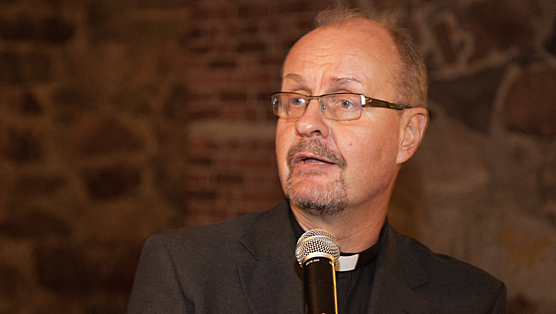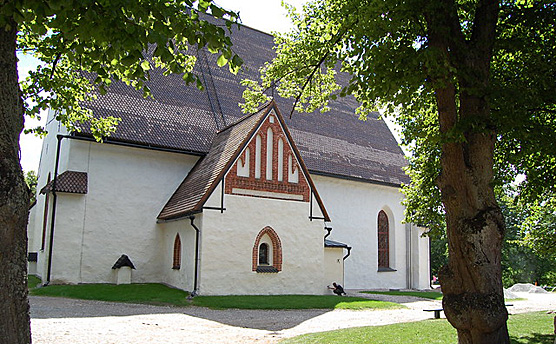
Ilkka Sipiläinen © Kirkon kuvapankki/Aarne Ormio
At the start of the year, the Evangelical Lutheran Church of Finland published a progressive climate strategy. Climate work will be done in parishes through the energy renovations of churches and the food served at confirmation schools and by protecting carbon sinks.
The Church aims to achieve carbon neutrality in its activities by 2030. In practice, this means cutting carbon dioxide emissions by 80% from the current level. The remaining emissions will be compensated by binding the carbon in forests or other natural areas, for example.
“No party can avoid the message by the scientific community about climate change or their own responsibility any longer when faced with the greatest challenge of humankind,” says Ilkka Sipiläinen, Senior Advisor, Church and Society and Sustainable Development, Church Council.
“It says something about how important this issue is that the plenary session of the Church Council approved our climate strategy unanimously. Now our role is to show a concrete example in climate work ourselves, while taking the message further with our own voice both in Finland and internationally,” he continues.
Modern technology meets buildings built to withstand time
Parishes own roughly 6,000 properties from parish halls and camp centres to medieval stone churches. In fact, the largest individual cause of climate emissions by the Church is the energy consumption of the buildings.
The energy palette of the buildings will be completely rebuilt – the use of electricity produced by oil and fossil fuels will be abandoned by 2025.
“On the one hand, the energy renovation of old church buildings requires special expertise. On the other hand, many of these old buildings are prime examples of smart building that withstands time,” Sipiläinen notes. “Energy renovations are one part of the valuable work to preserve historically significant buildings.”
Energy from geothermal heat for Porvoo Cathedral
The Porvoo parish has implemented significant emission reductions by switching over from oil to geothermal heat in the heating of Porvoo Cathedral. The project allows the parish to save up to 30,000 litres of oil every year. Energy produced by geothermal heat is used for heating the water and in the water circulation based heating of the church with radiators and underfloor heating.
Timo Kraufvelin, Facility Engineer for the Porvoo parish, expects that the system built from 2016 to 2018 will also bring relief during the summer heat, because the energy produced by the system can also be used to cool the facilities and control the humidity.
The cultural and historical significance of the church had to be taken into account in the project planning in addition to the water intake area located nearby, even if the Cathedral falls outside the protection zone of the water intake area. Due to the sensitive soil, a geothermal fluid safe for use in groundwater areas was selected for the heating system.

Porvoo Cathedral © VisitPorvoo/City of Porvoo
Energy wisdom in the Kirkkonummi parish
Last year, an OptiWatti remote optimisation system for direct electric heating was installed in the Haapajärvi Church in North Kirkkonummi, built out of logs in 1823. The wooden church is a protected building, which means that a major energy renovation is not possible.
“The church was formerly used year round, and a lot of electricity was consumed during the heating season when the cold building was heated for events on weekends. The constant changes in indoor temperature during the winter also caused a major humidity stress on the structures of the church,” says Property Manager Anna Antikainen of Kirkkonummi parish.
The remotely controlled smart system saves a considerable amount of time and trouble, because it optimises the temperature of the property in advance by taking the weather outdoors and the price of electricity into account. In addition to the wooden Haapajärvi Church, the remote optimisation system for electric heating has also been installed in the Räfsö camp centre.
Pluralism in forest management
Parishes have an ace in their sleeves: because they own as much as 167,000 hectares of forest in total, they have a major opportunity to compensate for their emissions. When the Church’s forest assets were mapped, their potential as natural carbon sinks that bind carbon emissions was also calculated.
“I believe that it is perfectly possible to combine the carbon-binding abilities of forests, natural biodiversity and spiritual values with responsible forest management. We ask the parishes to take this into account when planning the management of their forests,” says Sipiläinen. “Of course, many parishes are doing this already.”
Moving ahead one small step at a time
Sipiläinen has been working with issues related to sustainable development in the Church Council for a long time. He has seen how people often do environmental work every day by taking small but effective steps.
According to the new climate strategy, the confirmation camps of the Church serve climate-friendly vegetarian food. Church employees are encouraged to choose emission-free forms of travel instead of flying, compensate for their flights and participate in meetings remotely whenever possible. In addition, installing charging stations for electric cars at all road churches is recommended.
“We want to encourage all parishioners to join the effort to combat climate change, even if the main responsibility must be borne by the major actors: the state, municipalities, parishes and companies,” says Sipiläinen. “Churches are global actors, and we are also responsible for promoting international climate justice. We can help developing countries transition into clean technology by funding sustainable development activities in these countries, for example.”
The actions of ordinary people can also be effective. Sipiläinen highlights the young Swedish climate activist Greta Thunberg, who speaks to adults bravely and frankly.
“I’m not at all surprised that young people are worried, because they want to have faith in the future. Still, I believe that you should never lose hope, even if the situation is difficult. When we work in the right direction for the environment, a change for the better is possible,” Sipiläinen sums up.
More information:
Ilkka Sipiläinen, Senior Advisor, Church and Society and Sustainable Development, Church Council
tel. +358 40 5441 158, firstname.lastname@evl.fi